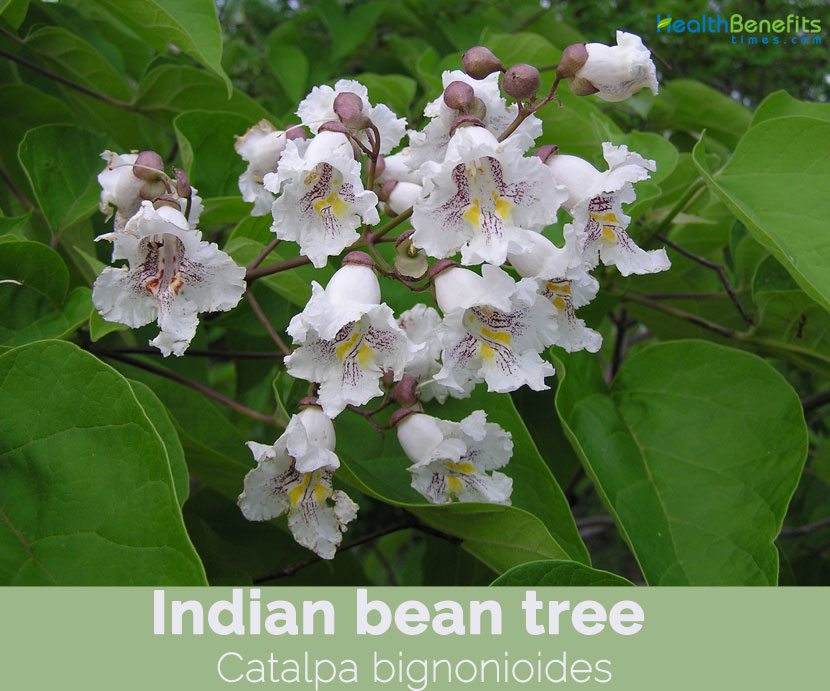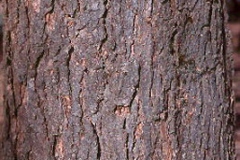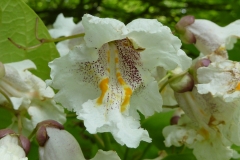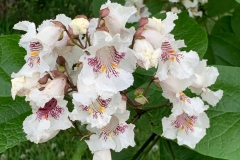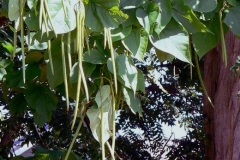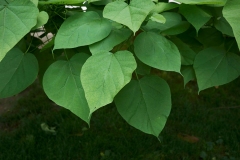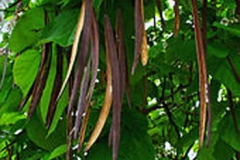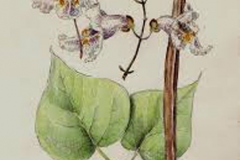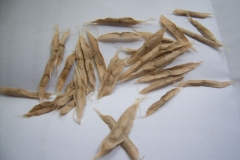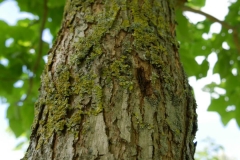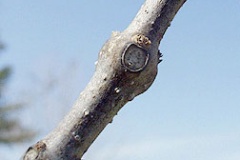| Indian Bean Tree Quick Facts | |
|---|---|
| Name: | Indian Bean Tree |
| Scientific Name: | Catalpa bignonioides |
| Origin | Southeastern United States in Alabama, Florida, Georgia, Louisiana, and Mississippi |
| Colors | Green when young turning to brownish as they matures |
| Shapes | Long slender capsule, nearly cylindrical, two-celled, partition at right angles to the valves |
| Taste | Bitter |
| Health benefits | Good for whooping cough, asthma, bronchitis, malaria, wounds and abrasions, trachoma, conjunctivitis, scrofulous ulcers, cancer and problems with the respiratory tract |
| Name | Indian bean tree |
|---|---|
| Scientific Name | Catalpa bignonioides |
| Native | Southeastern United States in Alabama, Florida, Georgia, Louisiana, and Mississippi |
| Common Names | Hardy catalpa, western catalpa, Catawba, Catawbatree, cigar tree, Indian bean tree, Indian cigar, Shawnee wood, early-flowering catalpa, Catalpa, Southern Catalpa, American Catalpa, Bean Tree, Caterpillar Tree, Eastern Catalpa, Fish Bait Tree, Fisherman’s Tree, Katalpa, Lady Cigar, Smoking Bean, Worm Tree |
| Name in Other Languages | Afrikaans: Catalpa Albanian: Catalpa, katalpë Amharic: Katapapa (ካታፓፓ) Arabic: Katalibana (كاتالبا), kitabat binyunia (كتلبة بنيونية) Armenian: Katalpa (կատալպա), Katalpa bignonianman (Կատալպա բիգնոնիանման) Azerbaijani: Katalpa Bengali: Catalpa Bulgarian: Katalpa (каталпа), bignonieva katalpa (бигнониева каталпа) Burmese: Catalpa Catalan: Catalpa Chinese: Qiū (楸), Mei guo zi, Mei guo zi shu, Nan fang zi Croatian: Catalpa, Katalpa Czech: Catalpa, Katalpa bignóniovitá, Katalpa truba, Katalpa trubachovitá, katalpa trubačovitá Danish: Catalpa, Almindelig trompetkrone, Trompetkrone, Trompettræ Dutch: Catalpa, Groene trompetboom, Trompetboom, gewone trompetboom English: Catalpa , Catawba, Caterpillar tree, Cigartree, Common catalpa, Eastern catalpa, Fish-bait tree, Indian-bean, Smoking-bean, Southern catalpa, Indian-bean-tree Esperanto: Catalpa Espanol: Indian-bean, Indian-bean-tree, Catawba, Cigartree, Common catalpa, Smoking-bean, Southern catalpa, Cigar tree Estonian: Katalpa Filipino: Catalpa Finnish: Catalpa, Alabamantrumpettipuu French: Catalpa , Arbre aux haricots, Catalpa commun, Catalpa de Caroline, Catalpa de la Caroline Georgian: k’at’alp’a (კატალპა) German: Catalpa, Gewöhnlicher Trompetenbaum, Trompetenbau, Amerikanischer Trompetenbaum, Gewöhnlicher Trompetenbaum, Trompetenbaum, Zigarrenbaum Greek: Katalápa (Καταλάπα) Gujarati: Ka catṭalpā (ક catટલ્પા) Hausa: Catalpa Hebrew: קטלפה , קטלפה ביגנונית Hindi: Catalpa Hungarian: Catalpa, Szívlevelű szivarfa Icelandic: Catalpa Indonesian: Catalpa Irish: Catalpa Italian: Catalpa, Bignonia catalpa, Catalpa americana, Catalpa commune, albero dei sigari Japanese: Zǐ (梓), Amerika ki sasage (アメリカキササゲ) Javanese: Catalpa Kannada: Kyāṭalpā (ಕ್ಯಾಟಲ್ಪಾ) Kazakh: Katalpa (каталпа) Korean: Katal pa (카탈 파), Kkot gae o dong Kurdish: Catalpa Lao: Catalpa-kəˈtalpə Latin: Catalpa Latvian: Katalpa Lithuanian: Katalpa Macedonian: Katalpa (Каталпа) Malagasy: Catalpa Malay: Catalpa Malayalam: Catalpa-kəˈtalpə Maltese: Catalpa Marathi: Kĕṭalapā (कॅटलपा) Mongolian: Katalpa (каталпа) Nepali: Catalpa Norwegian: Catalpa, Vanlig trompettre Oriya: Catalpa Pashto: کټالټا Persian: کاتالپا, جوالدوزک Polish: Surmia, Katalpa zwyczajna, Surmia zwyczajna, Surmia bignoniowa, katalpa bignoniowa Portuguese: Catalpa, árvore-das-trombetas Punjabi: Kaiṭālapā (ਕੈਟਾਲਪਾ) Romanian: Catalpa Russian: Katalpa (катальпа), Katal’pa bignonievaia, Katal’pa bignonievidnaia (катальпа бигнониевидная) Serbian: Catalpa (цаталпа) Sindhi: ڪئٽيلپا Sinhala: Catalpa Slovak: Katalpa bignóniovitá Slovenian: Katalpa, Ameriška katalpa Spanish: Catalpa, Catalpa común, Árbol indio Sudanese: Catalpa Swedish: Catalpa, Katalpa, trumpetträd Tajik: Katalpa (каталпа) Tamil: Catalpa Telugu: Catalpa Thai: Catalpa Turkish: Katalpa Ukranian: Katalpa (катальпа), Katalʹpa bihnoniyevydna (Катальпа бігнонієвидна) Urdu: کیٹالپا Uzbek: Katalpa Vietnamese: Catalpa Welsh: Catalpa Zulu: Ikati |
| Plant Growth Habit | Small to medium sized, fast growing, moderately short-lived deciduous tree |
| Growing Climates | Rich moist soils by the sides of streams and rivers, Stream banks, gravel bars, road cuts, bottomland forests, and fence rows |
| Soil | Grows best on open, moist, well drained alkaline and deep soils, but can grow across a range of moisture regimes once established |
| Plant Size | 15–18 meters (49–59 ft.) tall, with a trunk up to 1 meter (3 ft. 3 in) diameter |
| Root | Fibrous and branches are brittle, its juices are watery and bitter tasting |
| Wood | Light brown, sapwood nearly white; light, soft, coarse-grained and durable in contact with the soil |
| Bark | Young bark is smooth, dark-grayish, and spotted with lighter colored excrescences while older barks are scaly, brown, and from 3 to 6 lines in thickness |
| Leaf | Leaves are large, deciduous, simple, and broadly heart-shaped. Leaf margins are smooth, entire or slightly wavy |
| Flowering season | June to July |
| Flower | Trumpet shaped flowers are white in color with gold lines and purple spots within the throat. |
| Fruit Shape & Size | Long, slender, thin-walled, pod-like, two-celled capsules which dangle from ends of twigs. They look like long, thin, cylindrical pencils or cigars about 20–40 cm long and 8–10 mm diameter |
| Fruit Color | Green when young turning to brownish as they matures |
| Propagation | By Seed |
| Lifespan | 50–150 years (depending on conditions) |
| Seed | Seeds with wings are 1-2 inches long and 1/4 – 1/3 inch wide. They have a light brown coat and wings rounded at the ends terminating in a fringe of short hairs |
| Taste | Bitter |
| Season | October to December |
| Precautions |
|
Twigs
Southern catalpa twigs are thick, stout, and brittle. Twigs are minutely hairy and pale orange to brownish-grey in color. Many short crooked twigs and branches support a wide-spreading, irregular crown. Lenticels are clearly present on twig surfaces, and are large, pale and numerous. The terminal bud is absent and lateral buds are small (1/16 inches long), sunken, brown, and solitary with six overlapping bud scales. Twig pith is solid and white in color. Usually 10-12 vascular bundle scars are clearly visible in a circle-shape within the leaf scar. Leaf scars occur 2-3 per node. Neighboring leaf scars on the same node are not connected by lines and there are no stipular scars. Southern catalpa stem periderm is light reddish brown to grey in color. Periderm on young trees begins smooth and thin, eventually flaking off into thin, narrow scales
Bark
Tree bark ranges from scaly to ridged, to blocky plates. On a mature tree trunk the bark may be from ¾ to 1 inch thick, light grayish brown in color, and broken into longitudinal, scaly, flat ridges. On young tree seedlings the bark is thin and easily damaged by impact, or rodents.
Leaves
Two to three leaves grow from each node (an opposite or whorled leaf arrangement). Leaves are large, deciduous, simple, and broadly heart-shaped. Leaf margins are smooth, entire or slightly wavy. The leaf tip has an abruptly sharp point. The leaf base is heart-shaped and can occasionally have two small basal lobes. Leaves are connected to twigs with a long petiole that is about 3-6 inches long. Leaves are 5-10 inches long and 3-8 inches wide. Leaves are a bright medium green color and smooth on top, and paler green and slightly hairy (i.e. with trichomes) on the underside. Undersides of leaves are especially hairy on veins, with leaf hairs turning black by fall. Leaves produce an unpleasant aromatic odor when crushed. Leaves may scorch and drop during droughts. They turn an undistinguished yellow in the fall before dropping. They secrete nectar, a most unusual characteristic for leaves, by means of groups of tiny glands in the axils of the primary veins.
Flowers
Flowers of Indian bean tree are large, white, and showy, blooming just after leaves have expanded. Trees are normally cosexual (a tree having both sexual parts in one flower) with perfect flowers. Flowers are slightly fragrant, and 1 to 1.5 inches long and wide. Flowering occurs from June to July in large upright, pyramid-shaped flower clusters 7-11 inches tall and wide. Flowers are predominately white with a bell or tube shape. Each flower has a variety of yellow to orange, and purple to purple-brown lines, markings, or spots on its inner surfaces. Flower tubes each have five unequal, rounded, and fringed lobes with two upper lobes larger than the three lower lobes. The lowest or bottom-most lobe is not notched. Flower has two visible ridges and presents two rows of yellow-orange spots (or stripes) as well as many purple spots on the inner side of the flower tube and lower lobe. There are two fertile stamens present. Flowers are good for honey production.
Fruit
Fertile flowers are followed by long, slender, thin-walled, pod-like, two-celled capsules which dangle from ends of twigs. They look like long, thin, cylindrical pencils or cigars about 20–40 cm long and 8–10 mm diameter. Fruits are initially green which dries to a brownish color and eventually splits along two lengthwise seams. Fruits mature by October and are held on a tree until spring. Inside each fruit are many papery, thin, flat seeds with two long-pointed wings which have tufts of fringe hairs on each end.
Seeds with wings are 1-2 inches long and 1/4 – 1/3 inch wide. They have a light brown coat and wings rounded at the ends terminating in a fringe of short hairs. There are approximately 20,480 seeds per pound. Seeds which are collected after overwintering in the mature seedpod have a higher germination rate than those collected in the fall and stored.
Traditional uses and benefits of Indian bean tree
- Tea made from the bark has been used as an antiseptic, antidote to snake bites, laxative, sedative and vermifuge.
- It has been used with advantage in preparations with other herbs for the treatment of whooping cough in children.
- It is also used to treat asthma and spasmodic coughs in children.
- Bark has been used as a substitute for quinine in treating malaria.
- Leaves are used as a poultice on wounds and abrasions.
- Tea made from the seeds is used in the treatment of asthma and bronchitis and is applied externally to wounds.
- Pods are sedative and are thought to have cardio-active properties.
- Distilled water made from the pods, mixed with eyebright (Euphrasia officinalis) and rue (Ruta graveolens) is a valuable eye lotion in the treatment of trachoma and conjunctivitis.
- Pods and seeds have been used in decoction in chronic bronchial affections, spasmodic asthma, and dyspnea, and certain forms of functional heart disease.
- Leaves, bruised, and applied as a cataplasm, have been used in irritable scrofulous ulcers.
- Bark has been used internally, in powder, or in decoction, in scrofulous maladies, and as an anthelmintic.
- Juice of the leaves, as well as of the root, has been beneficially used as a local application in the several forms of strumous ophthalmia, as well as in certain cutaneous affections.
- Teas and poultices made from the bark and leaves are often used in herbal medicine to treat skin wounds and abrasions, infections, snake bites, and even malaria.
- Fruits and leaves of catalpa can be used for cancer and problems with the respiratory tract.
Other facts
- A fast-growing tree with an extensive root system, it has been planted on land that is subject to landslips or erosion in order to stabilize the soil.
- It is highly valued for posts and fencing rails, and is also used for interior finishes, cabinet work etc.
- Trees begin to flower by age seven and are usually producing good seed crops by age 10.
- The largest trees found measure 70 feet tall by 70 feet wide in Texas, and 75 feet by 75 feet in Mississippi.
- In summer, you can identify the tree by its white colored blossom/flowers.
- In autumn, you can identify it by the brown pods.
References:
https://www.itis.gov/servlet/SingleRpt/SingleRpt?search_topic=TSN&search_value=34313#null
https://npgsweb.ars-grin.gov/gringlobal/taxonomydetail.aspx?id=9581
https://pfaf.org/user/Plant.aspx?LatinName=Catalpa+bignonioides
http://www.missouribotanicalgarden.org/PlantFinder/PlantFinderDetails.aspx?kempercode=b962
http://www.floracatalana.net/catalpa-bignonioides-walt
https://en.wikipedia.org/wiki/Catalpa_bignonioides
http://tn-grin.nat.tn/gringlobal/taxonomydetail.aspx?id=9581
https://gd.eppo.int/taxon/CTLBI
https://www.flowersofindia.net/catalog/slides/Indian%20Bean%20Tree.html
https://plants.usda.gov/core/profile?symbol=CABI8
http://www.theplantlist.org/tpl1.1/record/kew-320352
https://gobotany.nativeplanttrust.org/species/catalpa/bignonioides/
https://www.henriettes-herb.com/eclectic/kings/catalpa.html
https://plants.usda.gov/plantguide/pdf/pg_casp8.pdf
https://davesgarden.com/guides/articles/view/2057


